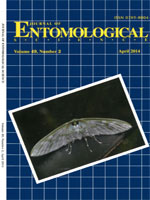Field collections of early nymphs of Nezara viridula (L.) revealed that normal change in coloration pattern occurring between the fourth and fifth stadia do not occur in some individuals producing abnormally-colored fifth instars. To determine if abnormal coloration is an indicator of poor health, field-collected fifth instars were grouped in 4 coloration pattern groups: (1) Green, normal coloration pattern; (2) faded, displaying similar patterns as “green” but with paler colors; (3) intermediate black-green; and (4) black, retaining fourth-instar coloration pattern. The fitness of nymphs within coloration pattern groups was measured by recording survival to adulthood and assessment of adult weight, fecundity, and egg viability. Adults originating from each nymphal coloration pattern were grouped to determine if the variability in nymphal coloration was hereditary. Survival from fifth instar to adult was significantly lower in nymphs displaying abnormal coloration patterns showing 21 and 12.5% survival in the black and faded groups, respectively, as compared with 76.2% in the normal green coloration group. Adults originating from nymphs of black coloration did not produce progeny, whereas adults originating from the faded coloration produced significantly less eggs with lower viability than adults originating from nymphs with normal coloration. However, adults originating from normally-colored nymphs produced progeny of abnormal coloration in similar frequency as adults originating from black and intermediate colored nymphs. Abnormal nymphal coloration can be used as an indicator of health and can aid in the selection of healthy individuals for culture.
How to translate text using browser tools
1 April 2014
Juvenile Coloration as a Predictor of Health in Nezara viridula (Heteroptera: Pentatomidae) Rearing
M. Guadalupe Rojas,
Juan A. Morales-Ramos
ACCESS THE FULL ARTICLE

Journal of Entomological Science
Vol. 49 • No. 2
April 2014
Vol. 49 • No. 2
April 2014
fecundity
nymphal coloration
rearing
Southern green stink bug
survival




